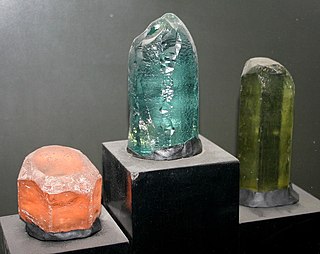
Beryl ( BERR-əl) is a mineral composed of beryllium aluminium cyclosilicate with the chemical formula Be3Al2Si6O18. Well-known varieties of beryl include emerald and aquamarine. Naturally occurring, hexagonal crystals of beryl can be up to several meters in size, but terminated crystals are relatively rare. Pure beryl is colorless, but it is frequently tinted by impurities; possible colors are green, blue, yellow, red (the rarest), and white. Beryl is also an ore source of beryllium.

Gold is a chemical element with symbol Au and atomic number 79, making it one of the higher atomic number elements that occur naturally. In its purest form, it is a bright, slightly reddish yellow, dense, soft, malleable, and ductile metal. Chemically, gold is a transition metal and a group 11 element. It is one of the least reactive chemical elements and is solid under standard conditions. Gold often occurs in free elemental (native) form, as nuggets or grains, in rocks, in veins, and in alluvial deposits. It occurs in a solid solution series with the native element silver and also naturally alloyed with copper and palladium. Less commonly, it occurs in minerals as gold compounds, often with tellurium.

Green is the color between blue and yellow on the visible spectrum. It is evoked by light which has a dominant wavelength of roughly 495–570 nm. In subtractive color systems, used in painting and color printing, it is created by a combination of yellow and blue, or yellow and cyan; in the RGB color model, used on television and computer screens, it is one of the additive primary colors, along with red and blue, which are mixed in different combinations to create all other colors. By far the largest contributor to green in nature is chlorophyll, the chemical by which plants photosynthesize and convert sunlight into chemical energy. Many creatures have adapted to their green environments by taking on a green hue themselves as camouflage. Several minerals have a green color, including the emerald, which is colored green by its chromium content.

Indigo is a deep and rich color close to the color wheel blue, as well as to some variants of ultramarine. It is traditionally regarded as a color in the visible spectrum, as well as one of the seven colors of the rainbow: the color between violet and blue; however, sources differ as to its actual position in the electromagnetic spectrum.

A quark is a type of elementary particle and a fundamental constituent of matter. Quarks combine to form composite particles called hadrons, the most stable of which are protons and neutrons, the components of atomic nuclei. Due to a phenomenon known as color confinement, quarks are never directly observed or found in isolation; they can be found only within hadrons, which include baryons and mesons. For this reason, much of what is known about quarks has been drawn from observations of hadrons.
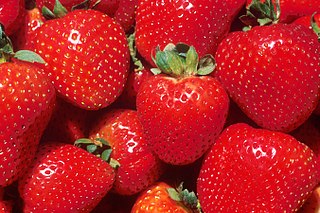
Red is the color at the end of the visible spectrum of light, next to orange and opposite violet. It has a dominant wavelength of approximately 625–740 nanometres. It is a primary color in the RGB color model and the CMYK color model, and is the complementary color of cyan. Reds range from the brilliant yellow-tinged scarlet and vermillion to bluish-red crimson, and vary in shade from the pale red pink to the dark red burgundy. The red sky at sunset results from Rayleigh scattering, while the red color of the Grand Canyon and other geological features is caused by hematite or red ochre, both forms of iron oxide. Iron oxide also gives the red color to the planet Mars. The red colour of blood comes from protein hemoglobin, while ripe strawberries, red apples and reddish autumn leaves are colored by anthocyanins.

Yellow is the color between orange and green on the spectrum of visible light. It is evoked by light with a dominant wavelength of roughly 570–590 nm. It is a primary color in subtractive color systems, used in painting or color printing. In the RGB color model, used to create colors on television and computer screens, yellow is a secondary color made by combining red and green at equal intensity. Carotenoids give the characteristic yellow color to autumn leaves, corn, canaries, daffodils, and lemons, as well as egg yolks, buttercups, and bananas. They absorb light energy and protect plants from photodamage. Sunlight has a slight yellowish hue, due to the surface temperature of the sun.

Violet is the color at the end of the visible spectrum of light between blue and the invisible ultraviolet. Violet color has a dominant wavelength of approximately 380-450 nanometers. Light with a shorter wavelength than violet but longer than X-rays and gamma rays is called ultraviolet. In the color wheel historically used by painters, it is located between blue and purple. On the screens of computer monitors and television sets, a color which looks similar to violet is made, with the RGB color model, by mixing red and blue light, with the blue twice as bright as the red. This is not true violet, for it does not match the color of a single wavelength shorter than that of blue light.

The visible spectrum is the portion of the electromagnetic spectrum that is visible to the human eye. Electromagnetic radiation in this range of wavelengths is called visible light or simply light. A typical human eye will respond to wavelengths from about 380 to 740 nanometers. In terms of frequency, this corresponds to a band in the vicinity of 430–770 THz.

The mineral pyrite (/ˈpaɪraɪt/), or iron pyrite, also known as fool's gold, is an iron sulfide with the chemical formula FeS2 (iron(II) disulfide). Pyrite is considered the most common of the sulfide minerals.
In mathematics, the dot product or scalar product is an algebraic operation that takes two equal-length sequences of numbers and returns a single number. In Euclidean geometry, the dot product of the Cartesian coordinates of two vectors is widely used and often called "the" inner product of Euclidean space even though it is not the only inner product that can be defined on Euclidean space; see also inner product space.

Blond or fair hair is a hair color characterized by low levels of the dark pigment eumelanin. The resultant visible hue depends on various factors, but always has some yellowish color. The color can be from the very pale blond to reddish "strawberry" blond or golden-brownish ("sandy") blond colors. Because hair color tends to darken with age, natural blond hair is generally very rare in adulthood. Naturally-occurring blond hair is primarily found in populations of northern European descent and is believed to have evolved to enable more efficient synthesis of vitamin D, due to northern Europe's lower levels of sunlight. Blond hair has also developed in other populations, although it is usually not as common, and can be found among natives of the Solomon Islands, Vanuatu, and Fiji, among the Berbers of North Africa, and among some Asians.

Eye color is a polygenic phenotypic character determined by two distinct factors: the pigmentation of the eye's iris and the frequency-dependence of the scattering of light by the turbid medium in the stroma of the iris.

Azure is a bright cyan-blue color that is often described as the color of the sky on a clear day.
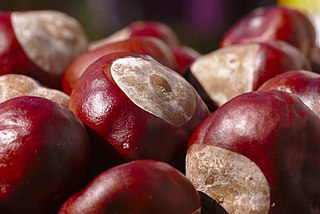
Maroon is a dark reddish purple or dark brownish red color that takes its name from the French word marron, or chestnut.

Pure gold is slightly reddish yellow in color, but colored gold in various other colors can be produced.
UCLA Blue is the dark azure color used in association with the University of California, Los Angeles (UCLA). It is described as a deep sky blue and is accompanied by a sun gold, UCLA Gold. Both are colloquially referred to as 'blue and gold'.
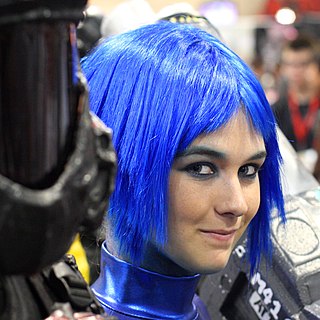
Blue hair is a type of hair color that does not naturally occur in human hair pigmentation, although the hair of some animals is described as blue. Some humans are born with bluish-black hair, which is black that has a blue hue under the light.

A xhamadan or xhamadani is a traditional wool garment, which is worn by Albanian men. It can be sleeved or sleeveless. The sleeveless xhamadan is only one type of the Albanian jelek, the other two being the jelek me reshme, and the jelek fermele. The jelek me reshme went out of use around the beginning of the 20th century. whereas the xhamadan and the jelek fermele continue to be used in traditional festivities. A good xhamadan is usually richly embroidered, sometimes in gold: in the past its quality revealed social rank.
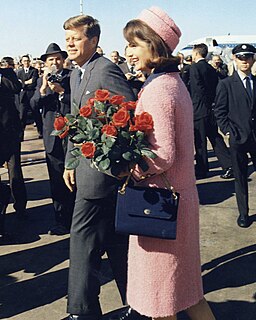
A pink Chanel suit was worn by Jacqueline Bouvier Kennedy on November 22, 1963, when her husband, President John F. Kennedy was assassinated in Dallas, Texas. Made of wool bouclé, the double-breasted, strawberry pink and navy trim collared suit was matched with a trademark matching pink pillbox hat and white gloves. After President Kennedy was assassinated, Jacqueline Kennedy insisted on wearing the suit, stained with his blood, during the swearing-in of Lyndon B. Johnson on Air Force One and for the flight back to Washington, D.C., with the president's body.

















